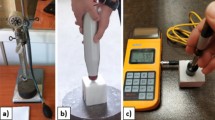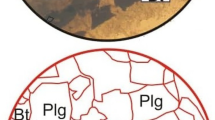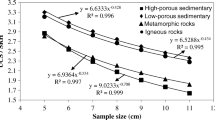Abstract
Prediction of physical and mechanical properties of rock materials using rebound-based hardness test methods is widely preferred in many fields of engineering and in the characterization of rock materials, because they are non-destructive, practical, and economical. In this study, 40 types of rocks with magmatic, metamorphic, and sedimentary origins, represented by travertine, limestone, marble, dolomite, granite, syenite, dunite, andesite, schist, gabbro, tuff, and ignimbrite were selected. First, dry unit weight (γd), open porosity (no), water absorption by weight (WAW), wide wheel abrasion (WA), and uniaxial compressive strength values were determined. After that, Shore C-2 scleroscope (HSC), L-type Schmidt hammer (HSL), and Leeb (HLD) rebound-based hardness tests were carried out on all samples, and then, hardness values by three methods were compared with the obtained parameters. The Leeb hardness test, which is more recent and innovative than the Shore and Schmidt hardness tests, was initially developed for metallic materials. However, the method has become increasingly popular in the determination of hardness of rock materials in laboratory as well as in field. In this study, the Leeb hardness test was found to be more useful due to its quick and precise measurement capabilities compared to Shore and Schmidt hardness tests. The results of the study reveal that the prediction of physical and mechanical properties of rocks can more precisely be determined by the HLD method than the HSL and HSC methods using the proposed equations.













Similar content being viewed by others
References
Altındağ R, Güney A (2006) ISRM suggested method for determining the shore hardness value for rock. Int J Rock Mech Min 43:19–22
Aoki H, Matsukura Y (2008) Estimating the unconfined compressive strength of intact rocks from Equotip hardness. Bull Eng Geol Environ 67(1):23–29
Asiri Y (2017) Standardized process for field estimation of unconfined compressive strength using Leeb hardness. MSc thesis, Dalhousie University, p 174
Asiri Y, Corkum AG, El Naggar H (2016) Leeb hardness test for UCS estimation of sandstone. In: Canadian Geotechnical Society, p 11
ASTM (1999) Standard test method for compressive strength of dimension stone (Designation: C 170). Annual Book of ASTM Standards
ASTM (2002) Standard test method for Leeb hardness testing of steel products. ASTM International A956-12
ASTM (2013) Standard hardness conversion tables for metals relationship among Brinell hardness, Vickers Hardness, rockwell hardness, superficial hardness, Knoop Hardness, Scleroscope hardness, and Leeb hardness. ASTM International E140-12b
Atkinson RH (1993) Hardness test for rock characterization. In: Hudson JA (ed) Comprehensive rock engineering: principles, practice and projects. Rock testing and site characterization, vol 3. Pergamon, Oxford, p 1011
Aydın A, Basu A (2005) The Schmidt hammer in rock material characterization. Eng Geol 81:1–14
Bruno G, Vessia G, Bobbo L (2013) Statistical method for assessing the uniaxial compressive strength of carbonate rock by Schmidt hammer tests performed on core samples. Rock Mech Rock Eng 46:199–206
Büyüksağış İS, Göktan RM (2007) The effect of Schmidt hammer type on uniaxial compressive strength prediction of rock. Int J Rock Mech Min 44:299–307
Çobanoğlu İ, Çelik SB (2008) Estimation of uniaxial compressive strength from point load strength, Schmidt hardness and P-wave velocity. Bull Eng Geol Environ 67:491–498
Çobanoğlu İ, Çelik SB (2017) Assessments on the usability of Wide Wheel (Capon) test as reference abrasion test method for building stones. Constr Build Mater 151:319–330
Çobanoğlu İ, Çelik SB, Alkaya D (2010) Correlation between “wide wheel abrasion (capon)” and “Bohme abrasion” test results for some carbonate rocks. Sci Res Essays 5(22):3398–3404
Coombes MA, Feal-Pérez A, Naylor LA, Wilhelm K (2013) A non-destructive tool for detecting changes in the hardness of engineering materials: application of the Equotip durometer in the coastal zone. Eng Geol 167:14–19
Corkum AG, Asiri Y, El Naggar H, Kinakin D (2018) The Leeb hardness test for rock: an updated methodology and UCS correlation. Rock Mech Rock Eng 51:665–675
Daniels G, McPhe CA, Sorrentino YC, McCurdy P (2012) Nondestructive strength index testing applications for sand failure evaluation. In: SPE Asia Pacific oil and gas conference and exhibition, society of petroleum engineers, p 12
EN 14157 (2006) Natural stones—determination of abrasion resistance. European Standard, p 19
EN 1926 (2006) Natural stone test methods—determination of uniaxial compressive strength. European Committee for Standardization, p 20
EN 1936 (2006) Natural stone test methods—determination of real density and apparent density, and of total and open porosity. European Committee for Standardization, p 11
Güneş Yılmaz N (2013) The influence of testing procedures on uniaxial compressive strength prediction of carbonate rocks from Equotip hardness tester (EHT) and proposal of a new testing methodology: hybrid dynamic hardness (HDH). Rock Mech Rock Eng 46(1):95–106
Güneş Yılmaz N, Göktan RM (2018a) Comparison and combination of two NDT methods with implications for compressive strength evaluation of selected masonry and building stones. Bull Eng Geol Environ. https://doi.org/10.1007/s10064-018-1382-7
Güneş Yılmaz N, Göktan RM (2018b) Analysis of the Leeb hardness test data obtained by using two different rock core holders. Süleyman Demirel Univ J Nat Appl Sci 22(1):24–31
Güneş Yılmaz N, Tumaç D, Göktan RM (2015) Rock cuttability assessment using the concept of hybrid dynamic hardness (HDH). Bull Eng Geol Environ 74:1363–1374
Gupta V, Sharma R, Sah MP (2009) An evaluation of surface hardness of natural and modified rocks using Schmidt hammer: study from northwestern Himalaya, India. Geografiska Annaler 91A(3):179–188
Hack HR, Hingira J, Verwaal W (1993) Determination of discontinuity wall strength by Equotip and ball rebound tests. Int J Rock Mech Min Geomech Abs 30(2):151–155
Hucka V (1965) A rapid method of determining the strength of rocks in situ. Int J Rock Mech Min Geomech Abs 2:127–134
ISRM (2007) The complete ISRM suggested methods for rock characterization, testing and monitoring: 1974–2006. In: Ulusay R, Hudson JA (eds) Suggested methods prepared by the commission on testing methods, ISRM, Compilation arranged by the ISRM Turkish National Group, p 628
Kahraman S (2001) Evaluation of simple methods for assessing the uniaxial compressive strength of rock. Int J Rock Mech Min 38:981–994
Karaca Z, Deliormanli AH, Elçi H, Pamukcu C (2010) Effect of freeze-thaw process on the abrasion loss value of stones. Int J Rock Mech Min 47(7):1207–1211
Karaca Z, Güneş Yılmaz N, Göktan RM (2012) Considerations on the European standard EN 14157 test methods: abrasion resistance of natural stones used for flooring in buildings. Rock Mech Rock Eng 45:103–111
Katz O, Reches Z, Roegiers JC (2000) Evaluation of mechanical rock properties using a Schmidt Hammer. Int J Rock Mech Min 37:723–728
Kawasaki S, Tanimoto C, Koizumi K, Ishikawa M (2002) An attempt to estimate mechanical properties of rocks using the Equotip hardness tester. J Soc Eng Geol 43(4):244–248
Kompatscher M (2004) Equotip—rebound hardness testing after D. Leeb. In: Conference on hardness measurements theory and application in laboratories and industries, pp 66–72
Koncagül EC, Santi PM (1999) Predicting the unconfined compressive strength of the Breathitt shale using slake durability, Shore hardness and rock structural properties. Int J Rock Mech Min 36:139–153
Lee JS, Smallwood L, Morgan E (2014) New application of rebound hardness numbers to generate logging of unconfined compressive strength in laminated shale formations. In: 48th US rock mechanics—geomechanics symposium, vol 2, pp 972–978
Leeb D (1979) Dynamic hardness testing of metallic materials. NDT Int 12(6):274–278
Marini P, Bellopede R, Perino L, De Regibus C (2011) Optimisation of an abrasion resistance test method on natural stones. Bull Eng Geol Environ 70:133–138
Meulenkamp F, Alvarez Grima M (1999) Application of neural networks for the prediction of the unconfined compressive strength (UCS) from Equotip hardness. Int J Rock Mech Min 36(1):29–39
Mol L (2014) Measuring rock hardness in the field. In: Nield J, Clarke L (eds) Geomorphological techniques. British Society for Geomorphology, p 8
Momeni E, Nazir R, Armaghani DJ, Mohamad ET (2015) Prediction of unconfined compressive strength of rocks: a review paper. Jurnal Teknologi 77(11):43–50
Proceq (2014) Pundit lab/Pundit lab + ultrasonic instrument operating instructions. Proceq SA, p 31
Proceq (2016) Portable nondestructive concrete testing instrument. Proceq SA, p 10
Schmidt E (1951) Investigations with the new concrete test hammer for estimating the quality of concrete. Schweizer Archive angerwandte Wissenschaft Technik (Solothurn) 17(5):139
Selçuk L, Nar A (2016) Prediction of uniaxial compressive strength of intact rocks using ultrasonic pulse velocity and rebound-hammer number. Q J Eng Geol Hydroge 49(1):67–75
Selçuk L, Yabalak E (2015) Evaluation of the ratio between uniaxial compressive strength and Schmidt hammer rebound number and its effectiveness in predicting rock strength. Nondestruct Test Eva 30(1):1–12
Shalabi FI, Cording EJ, Al-Hattamleh OH (2007) Estimation of rock engineering properties using hardness tests. Eng Geol 90(3):138–147
Siegesmund S, Dürrast H (2014) Physical and mechanical properties of rocks. In: Siegesmund S, Snethlage R (eds) Stone in architecture, properties, durability, 5th edn. Springer, Berlin
Su O, Momayez M (2017) Correlation between Equotip hardness index, mechanical properties and drillability of rocks. Dokuz Eylul Univ J Sci Eng 19(56):519–531
Tumaç D, Bilgin N, Feridunoğlu C, Ergin H (2007) Estimation of rock cuttability from shore hardness and compressive strength properties. Rock Mech Rock Eng 40(5):477–490
Verwaal W, Mulder A (1993) Estimating rock strength with the Equotip hardness tester. Int J Rock Mech Min Geomech Abs 30(6):659–662
Viles H, Goudie A, Grab S, Lalley J (2011) The use of the Schmidt Hammer and Equotip for rock hardness assessment in geomorphology and heritage science: a comparative analysis. Earth Surf Proc Land 36(3):320–333
Yağız S (2009) Predicting uniaxial compressive strength, modulus of elasticity and index properties of rocks using the Schmidt hammer. Bull Eng Geol Environ 68(1):55–63
Yaşar E, Erdoğan Y (2004) Estimation of rock physicomechanical properties using hardness methods. Eng Geol 71(3):281–288
Yılmaz I, Sendir H (2002) Correlation of Schmidt hardness with unconfined compressive strength and Young’s modulus in gypsum from Sivas (Turkey). Eng Geol 66(3):211–219
Acknowledgements
Portable hardness test device used in this study was financially supported by Pamukkale University Scientific Research Projects Coordination Unit under a project (no.: 2018KRM002-392); this support is gratefully acknowledged. Hardness measurements by Shore C-2 scleroscope were taken in the mining engineering department of Süleyman Demirel University; the authors wish to thank Prof. Dr. Raşit Altındağ and Dr. Deniz Akbay for their kind support.
Author information
Authors and Affiliations
Corresponding author
Additional information
Publisher's Note
Springer Nature remains neutral with regard to jurisdictional claims in published maps and institutional affiliations.
Rights and permissions
About this article
Cite this article
Çelik, S.B., Çobanoğlu, İ. Comparative investigation of Shore, Schmidt, and Leeb hardness tests in the characterization of rock materials. Environ Earth Sci 78, 554 (2019). https://doi.org/10.1007/s12665-019-8567-7
Received:
Accepted:
Published:
DOI: https://doi.org/10.1007/s12665-019-8567-7




